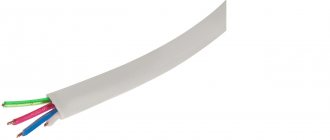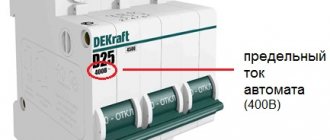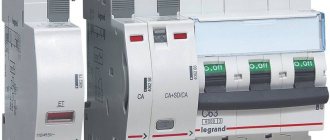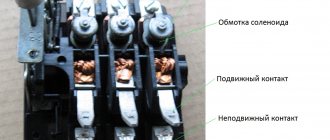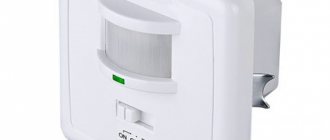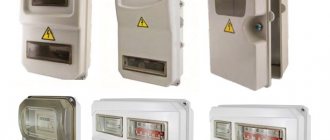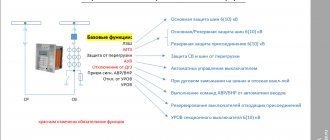The C32 circuit breaker is a circuit breaker that protects the network from overloads and short circuits. Also designed to manually turn on and off load currents. The machine is modular, because consist of separate single-pole blocks that can be used as single-phase or combined into two- or three-phase. This design makes it easy to assemble the required device of the required configuration. In case of breakdown, you can replace the individual damaged element.
General characteristics and markings of C32 circuit breakers
Single-pole circuit breaker C32
Many characteristics of the switch are indicated on its body. The main one is the rated current. This is the maximum current that the device passes in normal mode and for a long time. For the C32 machine it is 32 Amperes.
Another important characteristic is the ability of the protective device to turn off short-circuit currents of a certain value (switching capacity). After activation, the device must remain fully operational. The short circuit current is usually indicated in a rectangular box. For a 32 Ampere machine it is 4500 A, or 6500 A.
Industrial devices use additional characteristics:
- ultimate breaking capacity Icu—double operation current that does not damage the device;
- operating breaking capacity Ics - triple tripping current.
The higher the breaking capacity, the more reliable and durable the device.
In the process of disconnecting a short circuit, an electric arc flashes between the contacts of the switch. It has a high temperature and can destroy the device. Extinguishes using arc chutes. The faster this happens, the higher the current limiting class of the device:
- for first class - above 10 milliseconds;
- for the second - less than 10 milliseconds;
- for third grade - from 3 to 6 milliseconds.
This characteristic is marked with the numbers 2 or 3 in a square frame. If there is no such marking, it is a 1st class machine gun.
During operation, short-term surges of current or load may appear in the electrical network. This is due, for example, to turning on or off powerful electrical receivers. May lead to false protection alarms. To avoid this situation, time-current characteristics are used: the ratio of the operating current to the shutdown time.
In any machine there are two automatic shut-off elements.
- Electromagnetic release. Designed to trigger when short circuit currents occur. Operated by a current relay.
- Thermal release. Triggers when heated due to overload of the protected area. Based on the operation of a bimetallic contact.
Time-current characteristics are calculated for each separately. They are designated by Latin letters A, B, C, D and are indicated together with the rated current. For the C32 assault rifle this is characteristic “C”.
In order to protect against overload currents, the thermal release is adjusted to certain values. For circuit breaker C32, the time-current characteristic is 1.13-1.45 of the rated current. This means that a device with a rating of 32 Amperes will turn off in an hour at a current of 1.13 × 32A = 36.2 Amperes. If 1.45×32=46 Amperes flow, it will turn off in less than an hour. As the overload increases, the tripping speed will decrease until the electromagnetic release starts to operate.
Electromagnetic release C32 will operate when the current increases 5 times above the rated current - after 0.1 seconds; if the current exceeds the rated current by 10 times, faster than 0.1 seconds.
How to calculate the power of a machine
In order to provide the most effective and accurate overload protection, the formula is used to calculate the machine’s power for a 220V network:
in which the rated current is expressed by I, the sum of the powers of all powered consumers including lighting devices is P, and the voltage of the electrical network is U. Thus, the value of the rated current will increase with an increase in the total power of consumers.
And for a 380V network, the power calculation of the machine is made according to the formula:
in which the cosφ value is added, meaning the power factor (the exact value can be found in Table 6.12 of the SP 31-110-2003 standard “Design and installation of electrical installations in residential and public buildings”). To simplify calculations in everyday conditions, cosine phi is taken equal to one. In general, this coefficient depends on the type of electrical receiver, for example:
- for lighting networks with fluorescent lamps, the power factor is 0.92;
- for lighting networks with incandescent lamps - one;
- for gas-light advertising installations - from 0.35 to 0.4;
- for computers without technological air conditioning - 0.65;
- for refrigerators and air conditioners with an electric motor up to 1 kW, cosφ is equal to 0.65, and with a motor of 1 - 4 kW, the power factor increases to 0.75.
Let's try to calculate the machine's power using an example. Let's say you are trying to protect a group of three kitchen outlets from short circuits. In one, a refrigerator with a power of 400 W is constantly turned on, in others, a microwave or kettle (1000 W) or a blender (300 W) is periodically connected. Let's calculate the total power if you want to simultaneously connect the most powerful devices: 400 + 1000 + 1000 = 2400 W. The current strength for a 220V network is as follows:
2400/220 = 10.9A
And we recommend choosing a machine based on power in favor of the closest 10A rating. A natural concern may arise: will it “knock out” when applying more voltage to such a nominal value? In fact, if you apply a load of 15 amps to a 10-amp protective device, the operation will occur in eight minutes, and if you apply 11 amps, then it will take as long as twenty minutes. During this time, the kettle will turn off and the load will again become acceptable - much earlier than the release switches on.
How to choose a circuit breaker in the case of a three-phase input, which is relevant for private houses and some new buildings? You can either use the power factor formula or refer to the table.
Rated voltage and load power
Thanks to its modular design, the 32-amp machine can be assembled into blocks of various configurations. In a single-phase circuit it can be single- or double-pole. In three-phase at 380 Volts - three-pole and four-pole. Two-pole ones can also be used in a two-phase circuit, but such networks are rarely used. Protection is usually installed on phase wires. When installed on phase-neutral (2- and 4-pole) switches, they are mechanically connected for simultaneous disconnection.
The 32 A machine is designed for an alternating current voltage of ∼230/400 V. The device is capable of operating for a long time at a given level. When using one pole, the nominal voltage is 230 Volts. When used in a two- or three-phase circuit, when the modules are combined into multi-pole devices - 400 Volts.
Load power is calculated by the formula P=U×I, where P is power, U is network voltage, I is rated current. For a single-phase network of 230 Volts × 32 Amperes, we get 7360 Watts.
A three-pole 32 A circuit breaker is calculated for a three-phase network: 400 Volts × 32 Amperes = 12800 Watts. Since the voltage values are averaged, you need to select a load that is 10% less than the calculations: 7 kW for one phase, 12 kW for three.
Power calculation using an online calculator
First of all, you need to enter the initial data in the appropriate columns. On the calculator, these indicators include the number of phases, network voltage and load power. The first two points are known in advance, and calculations of the power of devices and equipment are carried out manually.
The voltage for a single-phase network is set to 220 volts, for a three-phase network – 380 V and higher. After entering the parameters, all that remains is to click on the “Calculate” button and get the required result. In the corresponding window, data will appear on the rated current of the circuit breaker most suitable for the given network.
Application of S32 assault rifles
A 32 ampere circuit breaker is installed in residential and administrative buildings. Mixed loads, heating and lighting devices, household appliances and electronics are their main areas of application. They do an excellent job protecting household appliances and electronics. They are used as input - installed before meters, or as protection for individual consumers.
It is not recommended to turn on powerful electric motors through C32 devices, even if they are suitable for the load. The time-current characteristic “C” indicates that the protection may falsely operate due to inrush currents.
Selection of machine according to cable cross-section table
We briefly mentioned that choosing a circuit breaker based on power is only half the battle. The table of machine power printed above must be combined with the cable cross-section table. If the wiring does not correspond to the rating of the AB, as well as the total power passing through it, it will overheat, and then the insulation may melt and even fire.
This often happens in old houses, when residents thoughtlessly connect powerful modern equipment to the network. The total load on the circuit seems to correspond to the selected current equivalent of the circuit breaker, there are no questions here. However, despite the correct choice of power protection and the readiness of the network for operation, the smell of burnt wiring appears in the house, and smoke and fire are quite likely.
One of the main mistakes is to calculate the rating and power of the machine correctly, but not take into account the wiring characteristics. The network will not be cut off until the rating is exceeded, and thin heated wires will gradually melt the insulation. The result may be a short circuit, as a result of which the machine will work, but the situation becomes critical if fire has spread through the house.
Therefore, we offer you a new table on how to choose a circuit breaker, taking into account the current, power and cross-section of the conductor in mm.
| Electrical wiring cross-section, mm | Voltage 220V | Voltage 380V | ||
| current, A | power, kWt | current, A | power, kWt | |
| 120 | 300 | 66,0 | 260 | 171,6 |
| 95 | 260 | 57,2 | 220 | 145,2 |
| 70 | 215 | 47,3 | 180 | 118,8 |
| 50 | 175 | 38,5 | 145 | 95,7 |
| 35 | 135 | 29,7 | 115 | 75,9 |
| 25 | 115 | 25,3 | 90 | 59,4 |
| 16 | 85 | 18,7 | 75 | 49,5 |
| 10 | 70 | 15,4 | 50 | 33,0 |
| 6 | 46 | 10,1 | 40 | 26,4 |
| 4 | 38 | 8,3 | 30 | 19,8 |
| 2,5 | 27 | 5,9 | 25 | 16,5 |
| 1,5 | 19 | 4,1 | 16 | 10,5 |
Let’s summarize how to choose a machine as correctly as possible. It doesn’t matter how many electrical appliances you connect, only their total power is important. It is also extremely important to know the wiring cross-section. If you have a non-uniform cable cross-section in a line, your task is to protect the weakest section (this means the section with the minimum cross-section).
Thus, when you ask the question of how much load a 16 amp circuit breaker can withstand, or how many amps a 15 kW machine corresponds to, the answer will not be complete without understanding the condition of your wiring. There is a good chance that it will need to be replaced if you live in an older home and your energy consumption needs have increased.
The cross-section of the current-carrying cable must withstand the total power of simultaneously connected electrical appliances.
Connection diagram
The wire feeding the switch is connected to a fixed contact, which is usually located on top. The wire to the power receiver is connected at the bottom. To avoid confusion, a simple diagram indicating the contacts is drawn on the case. They are signed with the numbers 1-input, 2-out. In the three-phase version it is similar: even numbers are supply contacts, odd numbers are outputs.
In modern electrical installations, additional devices are used in conjunction with automatic machines: RCD (residual current device), additional contacts, load switches, automatic switching devices. For reliable operation, it is recommended to install devices of the same series from the same manufacturer.
The choice of manufacturers of protective devices is huge. Domestic enterprises can offer reliable equipment, but the range is extremely narrow. The production of additional devices is very rare. Among foreign companies, ABB stands out, having a serious scientific and technical base. Brands such as Legrand, Siemens, GE, Schneider, Electric, Hager also deserve attention. The choice of equipment should be made for a specific project, looking at the range, which is often limited.



